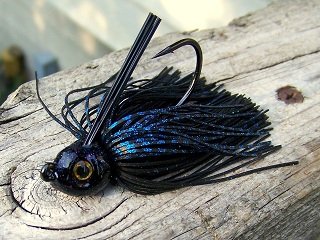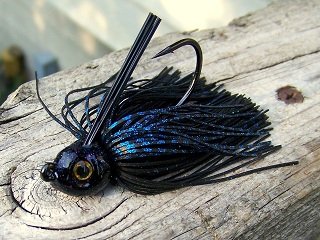 When it comes to bass fishing, jigs are among the most popular lures found in tackle boxes, and with good reason. While most think of bottom bouncing, skirted baits when they hear “jig,” they’re also made in another variation: the swim jig. It’s odd that swim jigs aren’t as well-known as their bottom-dwelling counterparts, they can be used to pick apart bodies of water to find and attract fish. Keep reading to learn how they can work wonders for you the next time you’re on the water.
When it comes to bass fishing, jigs are among the most popular lures found in tackle boxes, and with good reason. While most think of bottom bouncing, skirted baits when they hear “jig,” they’re also made in another variation: the swim jig. It’s odd that swim jigs aren’t as well-known as their bottom-dwelling counterparts, they can be used to pick apart bodies of water to find and attract fish. Keep reading to learn how they can work wonders for you the next time you’re on the water.
The swim jig’s versatility is really what makes it such a great lure throughout the spring and summer months. You can work them like a spinnerbait, but they’re subtle presentations can set them apart when blades are a bit too much and the cover is a little too thick. They also tend to not get hung up as much and if a big fish strikes, there’s no wire to worry about bending or breaking. Like spinnerbaits, swim jigs also mimic shad perfectly, which makes them a prime target for hungry bass looking for an easy meal.
Swim jigs are designed to cover water and find fish. However, your retrieval speed will have to experimented with in order to find out what the fish are going for on a given day. There are times when working a jig fast across a pocket works and then there are times when swimming it over obstacles and dropping it into holes is the way to go. Vary your speed and add a few rod twitches here and there until you figure out what’s working.
When choosing a jig, it’s smart to pair the weight with your tactics. Lighter jigs work well when you’re using a fast retrieval and you want to keep the jig high in the water. Heavier jigs work well when you need to let the jig drop into grass pockets during the retrieval. The trailer you choose will have an effect on your jig’s presentation as well. Thicker, chunkier trailers add a ton of vibration in the water, while a thinner trailer like a fluke will slice through the water and even cover swiftly. For skirts, you’ll want to choose a darker color—black or blue—for darker water and brighter ones—shad or white—for clearer waters.
Swim jigs are a great way to cover water and seek out holding fish when a little change of pace from spinnerbaits is in order. Not only will they perform better in cover, but their versatility as a lure enables them to be fished in a variety of different ways throughout the season. If you haven’t yet experimented with swim, then it might be time to see what you’ve been missing.








